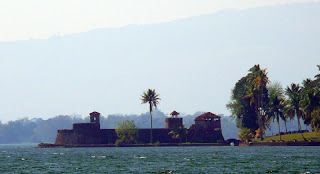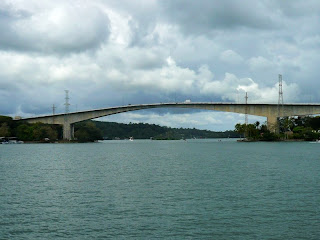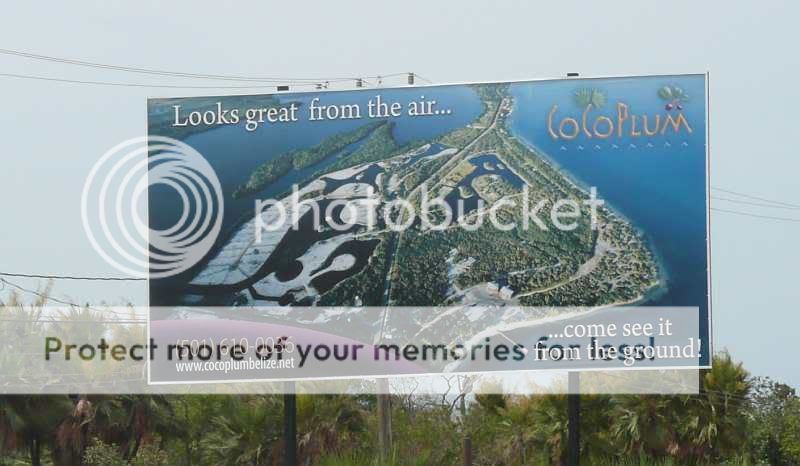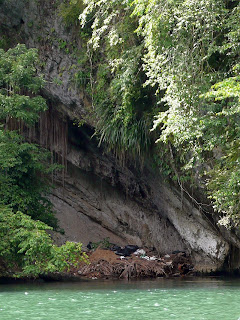We spend several days moored upstream of the one and only bridge across the Rio Dulce, at Fronteras. It’s been wonderful to jump off the boat at will into fresh water, and in this heat it’s a remedy taken regularly!
 Upstream is a fort, San Felipe, which had something to do with protecting warehouses of Spanish gold further upstream in Lake Izabel. More information is needed about that – what kind of boats could have made it up, or down the river with treasure without getting picked off?
Upstream is a fort, San Felipe, which had something to do with protecting warehouses of Spanish gold further upstream in Lake Izabel. More information is needed about that – what kind of boats could have made it up, or down the river with treasure without getting picked off?
 Downstream is a modern, concrete, 85’tall bridge which carries almost all the vehicular traffic that’s anywhere near the river. All the time we’ve been here there has been what I thought was road work in one spot near the top. There’s a striped umbrella and a truck and usually a couple cars, or an 18-wheeler stopped there. (I just Googled the bridge to see if I could find out when it was actually built, and couldn’t. I did learn that last year during Semana Santa (Holy Week, just passed!) which is apparently a major party time particularly on the Rio, the bridge was used for bungee jumping. I copied this photo from a travelpod user claudia favre)
Downstream is a modern, concrete, 85’tall bridge which carries almost all the vehicular traffic that’s anywhere near the river. All the time we’ve been here there has been what I thought was road work in one spot near the top. There’s a striped umbrella and a truck and usually a couple cars, or an 18-wheeler stopped there. (I just Googled the bridge to see if I could find out when it was actually built, and couldn’t. I did learn that last year during Semana Santa (Holy Week, just passed!) which is apparently a major party time particularly on the Rio, the bridge was used for bungee jumping. I copied this photo from a travelpod user claudia favre)
We’d heard how wild and crazy things can get during this week, and by the looks of Claudia’s picture, we didn’t miss a thing by slipping downstream. The Rio Dulce, at least near Fronteras, is gradually becoming a destination for city Guatemalans on vacation. They build nice houses and buy Sea Rays and Silvertons and other floating palaces, then roar up and down, dragging wakes which probably haven’t been equalled since the last earthquake, and aren’t very kind to docks and river’s edge residences.
I made a comment about the striped umbrella on the bridge to a locally-connected gringo who’s been on the Rio for almost 20 years and here’s what he told me.
“This bridge is a real big deal. It’s the biggest bridge in the country. It took a long time and a lot of money to build, and the entire country, not just the people around here, are very proud of it. What you’re seeing is a booth where people stop to look around, get their picture taken, and a food stand. Yes, it’s a two-lane bridge, with lots of trucks, but people want to stop, and it’s accepted. The other traffic just goes around, or it stops too!!
“Things have changed a lot. There’s more electric, and cell phones, of course. Lots more outboard motors. Even fifteen years ago there was none of that. You wouldn’t have believed this place. An engine in your boat, that was a big deal.
“I know a man down in Livingston. Someone had given him an old engine which he used for a while, until he got a bad batch of fuel and couldn’t make it run any more. Luckily he had the sense to cover it with a tarp, but it sat there for quite some time. I was down there one day and saw it and said that maybe we could get this thing going again. So I cleaned it up, changed out a few things, and it started to run again.
“I got in my boat and came straight home. And you know, when I got back up the river to Fronteras, the first thing I heard was ‘Hey, how you put the spirit back in that man’s engine?”
“There was no way anyone could have come here faster, and there were no phones, no roads, nothing. So I’m still wondering, how did they put the spirit in the news?”





































